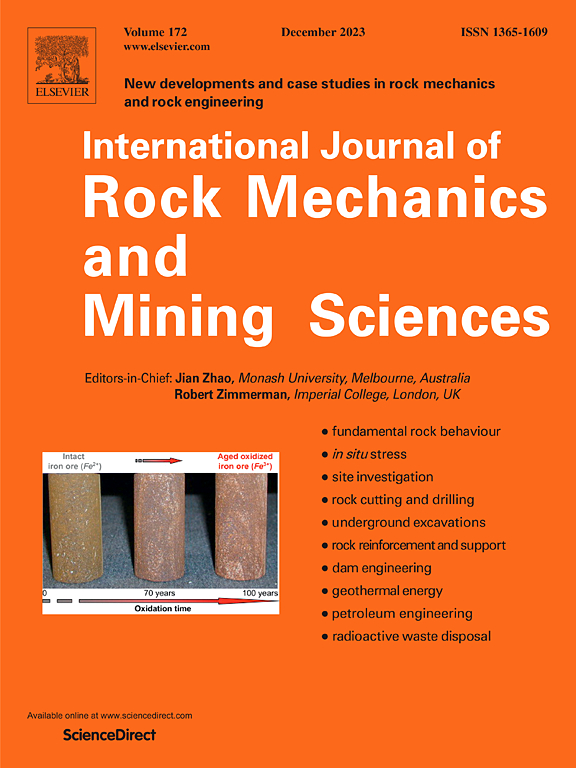A dynamic seepage analysis method for engineering-disturbed rock mass considering microseismic-derived fractures: a case study
IF 7
1区 工程技术
Q1 ENGINEERING, GEOLOGICAL
International Journal of Rock Mechanics and Mining Sciences
Pub Date : 2025-06-04
DOI:10.1016/j.ijrmms.2025.106168
引用次数: 0
Abstract
The evolution of fractures in rock masses induced by engineering disturbance is fundamental to the development of seepage pathways and changes in the seepage field, playing a critical role in the assessment of seepage-related disasters. This study proposes a dynamic seepage analysis method for engineering-disturbed rock mass considering microseismic(MS)-derived fractures. A three-dimensional random pre-existing fracture network model is established, with its connectivity determined through numerical water injection tests, and the preferential seepage channels are characterized using a graph structure. The coupling fracture models are constructed by integrating MS-derived fractures with the pre-existing fracture network, and the evolution of seepage field is tracked. The results show that among the size, number, dip direction and dip angle of MS-derived fractures, the connectivity is most influenced by the size. Increasing the MS-derived fracture radius from 0.5 m to 1 m enhances the model's water-holding rate by 47.87 % and connectivity rate by 11.46 %. The proposed method is applied to Jinzhou underground water-sealed storage cavern with seepage disasters. It is found that MS-derived fractures affect the seepage of the pre-existing fracture network in two ways: by directly connecting pre-existing fractures that were originally impermeable and non-interconnected to enhance the connectivity, and by indirectly changing the water pressure distribution in the surrounding rock mass. In addition, the locations of the preferential seepage channels during construction are identified, with seepage points exhibiting velocities of 1.93 × 10−5 m/s and 1.14 × 10−5 m/s. The results provide a new idea for identifying seepage channels and optimizing grouting schemes in engineering-disturbed rock mass.
考虑微震裂隙的工程扰动岩体动态渗流分析方法
工程扰动引起的岩体裂隙演化是渗流路径发展和渗流场变化的基础,在渗流灾害评价中具有重要作用。提出了一种考虑微震裂隙的工程扰动岩体动态渗流分析方法。建立了三维随机预存裂缝网络模型,通过数值注水试验确定了其连通性,并采用图结构对优先渗流通道进行了表征。将ms衍生裂缝与已有裂缝网络整合,建立耦合裂缝模型,并跟踪渗流场演化。结果表明:在ms衍生裂缝的大小、数量、走向和倾角中,连通性受裂缝大小的影响最大;将ms导出的裂缝半径从0.5 m增加到1 m,模型的持水率提高了47.87%,连通性提高了11.46%。将该方法应用于具有渗流灾害的锦州地下水封储库。研究发现,ms衍生裂缝通过两种方式影响既有裂缝网络的渗流,一种是通过直接连接原本不透水、互不连通的既有裂缝增强连通性,另一种是通过间接改变围岩水压分布。确定了施工过程中优先渗流通道的位置,渗流点速度分别为1.93 × 10−5 m/s和1.14 × 10−5 m/s。研究结果为工程扰动岩体渗流通道识别和注浆方案优化提供了新的思路。
本文章由计算机程序翻译,如有差异,请以英文原文为准。
求助全文
约1分钟内获得全文
求助全文
来源期刊
CiteScore
14.00
自引率
5.60%
发文量
196
审稿时长
18 weeks
期刊介绍:
The International Journal of Rock Mechanics and Mining Sciences focuses on original research, new developments, site measurements, and case studies within the fields of rock mechanics and rock engineering. Serving as an international platform, it showcases high-quality papers addressing rock mechanics and the application of its principles and techniques in mining and civil engineering projects situated on or within rock masses. These projects encompass a wide range, including slopes, open-pit mines, quarries, shafts, tunnels, caverns, underground mines, metro systems, dams, hydro-electric stations, geothermal energy, petroleum engineering, and radioactive waste disposal. The journal welcomes submissions on various topics, with particular interest in theoretical advancements, analytical and numerical methods, rock testing, site investigation, and case studies.

 求助内容:
求助内容: 应助结果提醒方式:
应助结果提醒方式:


